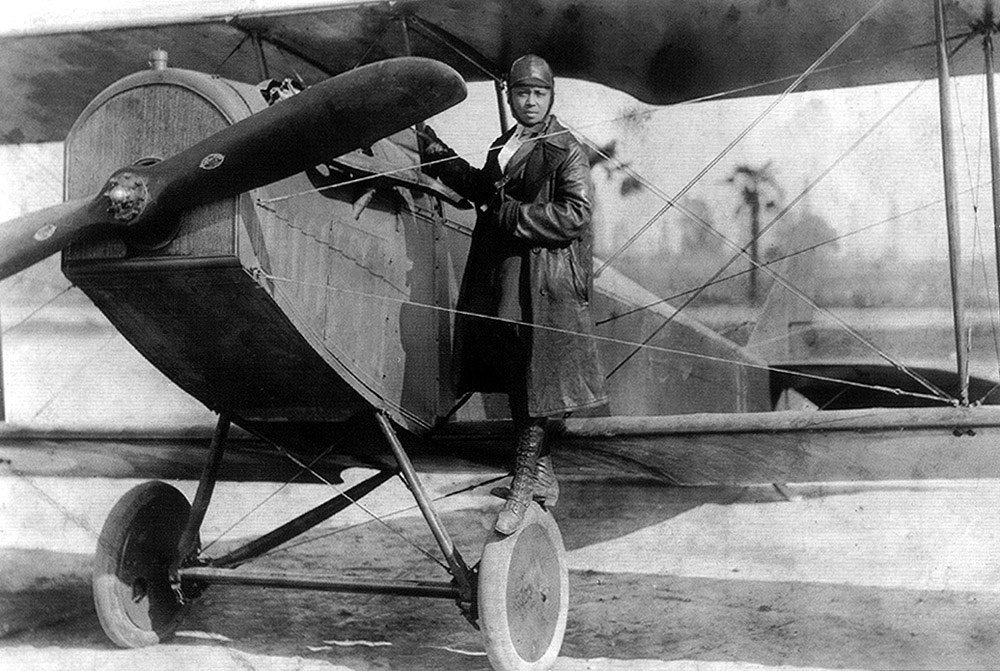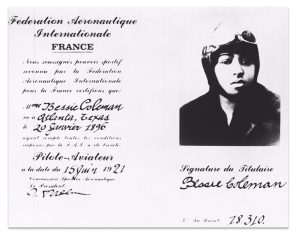 The web address still reads “hoover.csd509j.net”, but this link takes you to a redesigned site for Bessie Coleman Elementary School.
The web address still reads “hoover.csd509j.net”, but this link takes you to a redesigned site for Bessie Coleman Elementary School.
But who was Bessie Coleman? A pilot, okay – a pilot back when there were very few pilots, and when they were called by the romantic term “aviator” (or when a woman was likely to be called by the even more quaint term “aviatrix”). Being of mixed African, European and Cherokee ancestry, she was both the first African American woman and the first Native American woman to become a pilot, but that doesn’t really convey her accomplishments adequately.
Born in 1892, 11 years before the Wright Brothers flew their plane, and just 27 years after the Civil War, Coleman grew up surrounded by former enslaved descendants of the African diaspora, and being treated as less than human by her white neighbors. She was 28 years old before the 19th Amendment guaranteed her right to vote, and she died in a tragic flying accident in 1926, long before the Civil Rights Act of 1965 made it likely she would actually get a chance to vote. 
The tenth child of a sharecropper and a housemaid, she tried to work her way through college but was unable to pay her tuition. When her brother came home from the Great War and found her working as a manicurist, he told her he’d seen women in France going to flight school. Rejected by every flight school in the U.S. – for being Black, when she wasn’t rejected for being a woman – she learned French, earned an international pilot’s license overseas and returned to the states to perform daring aerobatic stunts for adoring crowds.
Crowds which, at her insistence were never segregated – a demand which shocked many venue owners of the 1920s. Her firmness on this matter prevented her from performing at many venues, but her growing fame, and the 1920s hunger for the thrill of seeing these newfangled aeroplanes in flight often outweighed resistance to integration.
In 1926, Coleman was preparing for a show in an unfamiliar plane, riding as a passenger, when it suffered mechanical trouble and began to tumble in the air. Coleman slipped out of her seat and fell hundreds of feet. She was killed instantly, not far from where the plane came down.
Coleman Elementary School is far from being the only way in which Bessie Coleman’s name and legacy is commemorated. She is honored in museums, in libraries, in street names, in public parks, and on public plaques. In 2023, the current American Women series of quarters will continue, and one of the honorees will be Coleman herself (the final design hasn’t been settled upon, but it might be something like the 1998 proposal for a Bessie Coleman dollar coin).
Still not enough? How about a mountain – one on the edge of that immense heart-shaped upland on Pluto? It’s there: Coleman Mons, a gigantic mountain (possibly a volcano) out there on the fringes of our solar system.
And speaking of the solar system, Dr. Mae Jemison, the first Black woman to travel to space, carried a picture of Coleman with her on her first mission in the Space Shuttle.
Despite having such a short life and facing such immense systemic obstacles, Bessie Coleman accomplished great things, and she’s finally getting the recognition that she deserves.
If you want to know more about Bessie Coleman, you can visit bessiecoleman.com.
By John M. Burt
Do you have a story for The Advocate? Email editor@corvallisadvocate.com


